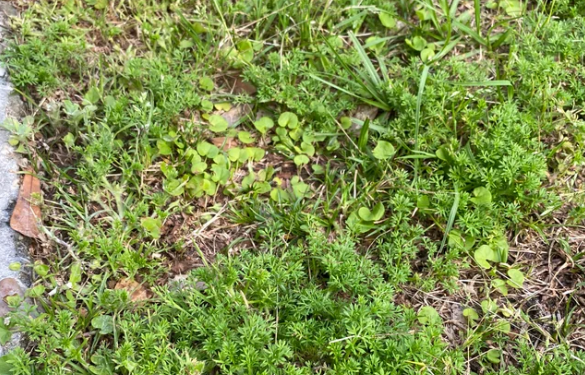Having a grassy lawn or a garden is all fun and games until those pesky stickers start attaching themselves to everything from your clothes to your pet’s fur. Not only could they potentially hurt you while walking barefoot, they could also cause serious damage to other plants.
If you are facing annoyances because of sticker weed, you have come to the right place. In this article, we discuss the different types of stickers and how to remove them for a happy and healthy lawn.
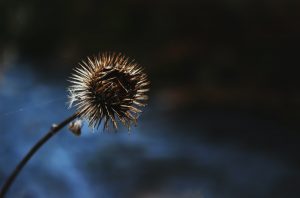
What Are Stickers?
Stickers or sticker weeds are plants which produce spiky or spiny foliage called sticker burrs. Sticker burrs have sharp, hook-like spikes protruding from them which adhere to clothing, footwear and pet fur.
These pesky little annoyances invade your lawn, making it a real pain in the ‘burr’. Terrible jokes aside, let’s discuss why plants produce in the first place. Spiky burrs are produced by plants as a defence mechanism– their thick, sharp-edged leaves prevent animals from eating the plant.
The burrs which you find on your pant legs or your dog’s fur are seeds which are designed to spread by adhesion. When the flowers of the burr-producing weed are pollinated, they produce tender green burrs which soon dry into tough and spiny burrs which are white or tan in colour.
If you find dried sticker burrs in your garden or lawn, it most likely means that the sticker weeds have already pollinated and it’s almost impossible to collect all the burrs before they sprout.
Also Read: The Obvious Reasons why You Should Sell Online Plants In Canada
Types Of Sticker Weeds
If your lawn or garden is becoming overrun with weed stickers, take a closer look at them to determine the type(s) of burrs you would be dealing with. Knowing the type of burr-producing weed growing in your lawn is the first step in eliminating it thoroughly. In the next section, we discuss 9 most commonly found types of burr stickers.
1. Burr Stickers
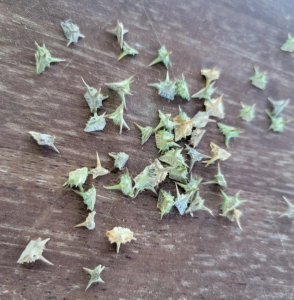
This annual weed thrives in warm climates and is generally found in the southern parts of the USA. Burr stickers grow in large, open pastures, along roadways and in sunny gardens. This plant’s green to yellow-green foliage makes it look deceptively like regular grass, but come late summer, the oval-shaped green seeds dry up and turn brown, resembling tiny pinecones.
2. Field Sandburr Stickers
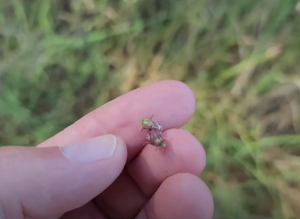
Also known as sandspur, field sandburr stickers produce seeds which are spikey and painful to the touch even when they are still green. When the seeds mature, they become slightly more yellow than the rest of the plant. These plants are tall and one of the most difficult weeds to eradicate from your garden.
3. Thistles
Thistles are a large type of stickers which can be easily identified by their rosette leaf pattern. They have tall stalks and long blue-green or yellow-green leaves which resemble dandelion leaves. These leaves have jagged edges which are sharp enough to cut through skin and leave scratches.
Thistles produce yellow, pink, purple, and white flowers at the ends of their tall stalks, and produce seeds which have parachute-like appendages to be pollinated by the wind. Thistles are incredibly stubborn and difficult to remove, so you must eradicate them as soon as possible from your garden.
4. Cockleburr
A cousin of sunflower, cockleburr is an extremely hardy weed which is toxic to livestock if ingested. If left unattended, this weed can easily grow up to 6 feet in height and take over your entire lawn or garden. Cockleburr plants are identifiable by their multiple brown, hairy stems growing from a single taproot, and rough leaves which look like watermelon or squash plant leaves.
Even though cockleburrs die at the end of every growing season, they leave behind huge quantities of seeds, which can survive in the soil for years. So, even if there is just one of these weeds in your garden, it can result in multiple in the future.
5. Burr Medic
Also known as California burr clover for its resemblance to clover, burr medic weeds can be very good for your yard, especially if you’re looking to re-wild it. This plant grows rapidly, is incredibly hard to remove, and produces white to yellow flowers, which give way to small, spiny burrs once pollinated.
Despite its invasive nature, burr weed can be beneficial for your garden as it grows well in nitrogen-deficient soils and increases nitrogen availability for other important plants. However, you should be careful with them as they can take over your garden if not kept in check.
6. Goathead Weed
Also known as caltrop or cat’s head, goathead weed thrives in dry, harsh conditions where other plants can’t survive. It resembles another weed, purslane, and is identifiable through its frond-like leaves and yellow, star-shaped flowers. You can also identify this plant by the clusters of small, thorny seeds it produces, which resemble a goat’s head.
7. Lawn Burrweed
This low-growing plant quickly covers a large portion of the ground could easily be mistaken for dill, fennel, or some kind of herb. It produces pale yellow to kelly green foliage and small, round flowers which give way to burrs which are similar in appearance to burr medic’s stickers. Since it only grows to be 3 to 4 inches tall, it can camouflage itself into the surrounding grass pretty well, so keep your eye out for this invasive weed.
8. Burdock
With its large, spear-spaed leaves which grow outward in a rosette pattern, burdock looks a lot like lettuce. The foliage is tough, leathery and covered in spines all over. Burdock burrs are round, tapering to a point at the end, and covered in long, uniform spines. Additionally, burdock has medicinal qualities which make it an excellent cure to treat digestive problems and even arthritis.
9. Stickseed
Also called beggar’s lice, stickseed is a native plant which produces small blue or purple flowers and hairy leaves which can irritate the skin upon direct contact. These weed stickers are commonly found in pastures, parks, and along roadways.
Since its stems are delicate and seeds have strong hook-like appendages, you might find the entire plant to your clothing. Stickseed is hardy and has medicinal properties which can be used to treat several skin conditions.
Also Read: Top 5 Medicinal Plants To Grow For Your Skin and Hair
How To Get Rid Of Sticker Weed?
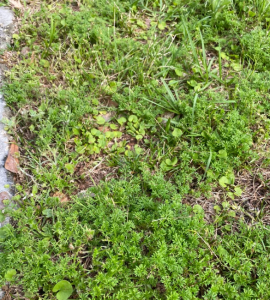
Once you have determined the type of stick weed in grass you are dealing with, you can get into removing them. Here are some of the most effective methods to eradicate these weeds.
1. Uproot Them By Hand
Although it may be time consuming, pulling these plants by hand is incredibly effective there are lesser chances of the roots being left behind. This method works best when the seeds haven’t spread yet, so work inspect your garden or lawn in early spring. In the event that you find sticker weeds in your garden, work quickly.
Uproot the plants at the earliest, making sure to remove their entire root system. You can use a weed fork or a trowel to aid the process. Importantly, make sure you wear garden gloves to protect your hands
2. Spray White Vinegar
The acetic acid present in vinegar is detrimental to plants, making it an effective tool to eradicate unwanted plants. Acetic acid affects the plant cells’ pH, inflicting significant damage to the cell membrane. This kills the weed’s tops first and then the roots.
Spray the plant with white vinegar, covering every inch of the plant thoroughly. Since white vinegar makes for an all-natural and safe herbicide, it is a pet-safe alternative to chemical herbicides. However, be careful while using it as it may kill the surrounding plants and grass if used carelessly.
3. Sprinkle With Salt
Like vingegar, salt works by damaging the plant’s cell membrane. When sprinkled on soil or foliage, salt draws out mixture from the plant in a process called osmosis, which causes the plant to dehydrate. Additionally, salt disrupts the plant cells’ pH balance, thus rendering it ineffective in absorbing nutrients it needs to make food.
Sprinkle a handful of salt on the weed and/or the soil surrounding it. However, bear in mind that salt can damage soil structure, create an inhospitable environment for plant growth, and pollute nearby waterways. So, use this method advisedly.
4. Pour Boiling Water
Even though most sticker weeds are resistant to hot and dry conditions, they cannot survive extreme temperatures. Extreme heat can effectively kill all kinds of weeds, especially solitary ones, like thistles.
Heat a potful of water and pour the boiling water directly over the weeds. Following this, they should shrivel up and die within a day or so. As with salt and vinegar, use this method carefully to avoid killing surrounding plants accidentally.
5. Use a Herbicide
If none of the above home remedies worked out, invest in a chemical herbicide. In the spirit of “prevention is better than cure”, pre-emergence herbicides like Benefin and Oryzalin will prevent sticker weeds from even sprouting in your lawn or garden.
If weeds have already invaded your yard, post-emergence herbicides containing monosodium methanearsonate (MSMA) will help kill the weeds. Once again, use this method carefully by following the manufacturer’s instructions.
Also Read: The Benefits of a Vegetarian Diet
Conclusion
To maintain a happy and healthy garden, lawn, or yard area, ensure to regularly inspect the grass for invasive weed growth. In case you find any, act immediately to remove them as they spread quickly and undo all the hard work you put into establishing your garden.


